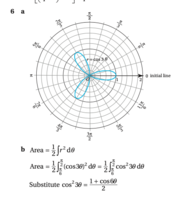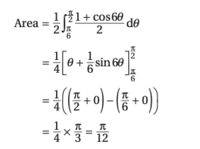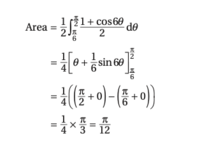You are using an out of date browser. It may not display this or other websites correctly.
You should upgrade or use an alternative browser.
You should upgrade or use an alternative browser.
Area of a polar curve.
- Thread starter Sonal7
- Start date
Dr.Peterson
Elite Member
- Joined
- Nov 12, 2017
- Messages
- 16,089
Please quote the problem. What area did they ask for? And is this the entire solution?
Q is now in the description.Please quote the problem. What area did they ask for? And is this the entire solution?
Anyway it worked, it goes from top limit to the other limit anticlockwise. I feel like a fool. Its given me the area of 1 petal, as the positives and the negatives (not shown in the diagram) cancel out, except for one less negative petal so you just get the area of 1 petal.
Sorry to be so silly, solved
the book is very clever, it makes one think deeply about polar equations.
Last edited:
Dr.Peterson
Elite Member
- Joined
- Nov 12, 2017
- Messages
- 16,089
Q is now in the description.
Anyway it worked, it goes from top limit to the other limit anticlockwise. I feel like a fool. Its given me the area of 1 petal, as the positives and the negatives (not shown in the diagram) cancel out, except for one less negative petal so you just get the area of 1 petal.
I don't see the actual wording of the problem anywhere.
If you're saying they asked for the total area enclosed by the curve, then there are no negatives involved. Areas are positive. Nothing cancels out. The only thing to watch for is to avoid going around the curve twice.
They found the area of one "negative" petal, which came out positive. (The same petal can be obtained using positive r with different angles.) I would probably have integrated from [MATH]-\pi/6[/MATH] to [MATH]\pi/6[/MATH] and multiplied by 3 as you imply you would do.
I checked. I just worked out the area of 1 petal and it is [MATH]\pi/12[/MATH]. Its easy to see why, the negatives cancel out, so in order to work out the area of negative and positives then you need to find area of 1 petal and times by the number of petal. Their answer does not indicate they did this. I agree, and now think their answer is wrong but just integrating like they did clearly gives the wrong answer! so watch out.I don't see the actual wording of the problem anywhere.
If you're saying they asked for the total area enclosed by the curve, then there are no negatives involved. Areas are positive. Nothing cancels out. The only thing to watch for is to avoid going around the curve twice.
They found the area of one "negative" petal, which came out positive. (The same petal can be obtained using positive r with different angles.) I would probably have integrated from [MATH]-\pi/6[/MATH] to [MATH]\pi/6[/MATH] and multiplied by 3 as you imply you would do.
Dr.Peterson
Elite Member
- Joined
- Nov 12, 2017
- Messages
- 16,089
The funny thing is, if you just integrate from 0 to pi, you get the right answer, and more obviously, it seems to me. There's no need to worry about negatives. (Notice that the integrand is positive, so you know nothing will cancel out.)
Now, if the integrand could be negative, you would have to integrate piece by piece and add absolute values (as you do in rectangular coordinates). Areas are never negative, so they never cancel out, but integrals can be negative: areas are absolute values of integrals.
Now, if the integrand could be negative, you would have to integrate piece by piece and add absolute values (as you do in rectangular coordinates). Areas are never negative, so they never cancel out, but integrals can be negative: areas are absolute values of integrals.
Thats well explained, in this case there are 5 petals in the limits specified which give, but 2 petals are when r is negative, so the abolute values are are the areas are still positive, I dont think you can do a full sweep as it will cancel out with the positives integrands-as their answer shows this are gives just area 1 petal. Sorry I am bad at explaining myself but i agree with you. Area is always positive so you have work out area of 1 petal and then all the petals. This is a an example. The question forgot to specify r>=0. They have asked to work out the area of loops of curves with the equations r=sin 4[MATH]\theta[/MATH]The funny thing is, if you just integrate from 0 to pi, you get the right answer, and more obviously, it seems to me. There's no need to worry about negatives. (Notice that the integrand is positive, so you know nothing will cancel out.)
Now, if the integrand could be negative, you would have to integrate piece by piece and add absolute values (as you do in rectangular coordinates). Areas are never negative, so they never cancel out, but integrals can be negative: areas are absolute values of integrals.
Attachments
Last edited:
Dr.Peterson
Elite Member
- Joined
- Nov 12, 2017
- Messages
- 16,089
What "limits specified"? Again, you haven't quoted the problem!!! (If your last sentence is supposed to be the problem, it's a different curve than the solution you showed.) Please be complete! This gets very frustrating.Thats well explained, in this case there are 5 petals in the limits specified which give, but 2 petals are when r is negative, so the abolute values are are the areas are still positive, I dont think you can do a full sweep as it will cancel out with the positives integrands-as their answer shows this are gives just area 1 petal. Sorry I am bad at explaining myself but i agree with you. Area is always positive so you have work out area of 1 petal and then all the petals. This is a an example. The question forgot to specify r>=0. They have asked to work out the area of loops of curves with the equations r=sin 4[MATH]\theta[/MATH]
This curve has 8 petals, 4 of which are traced with negative r. They've integrated over one of the "negative" petals, and multiplied by 4; so what area are they claiming to find? Just the negative petals?
If you just integrate from 0 to 2 pi, without multiplying by 4, you get pi/2, which is the area of all 8 petals. Nothing cancels out. The integrand is never negative. So I don't know what you're talking about.
7) show that the areas of the enclosed loops of the curves with the equations r=sin 4[MATH]\theta[/MATH] and r=cos 4[MATH]\theta[/MATH] for [MATH]0=<\theta<2\pi[/MATH] are the same.
The answer states that the area for r=sin 4[MATH]\theta[/MATH] had been shown in answer to question 5. The question did not state that r is >=0, so technically there were 8 petals but the answer shows the integrad of 4 petals (all positive). You cant just use [MATH]2pi[/MATH] and [MATH]0[/MATH] as limits, as the negative integrads will cancel out. So you have to do petal by petal.
The answer states that the area for r=sin 4[MATH]\theta[/MATH] had been shown in answer to question 5. The question did not state that r is >=0, so technically there were 8 petals but the answer shows the integrad of 4 petals (all positive). You cant just use [MATH]2pi[/MATH] and [MATH]0[/MATH] as limits, as the negative integrads will cancel out. So you have to do petal by petal.
It is negative, you have to make it positive. I completely disagree. but let me check it out.What "limits specified"? Again, you haven't quoted the problem!!! (If your last sentence is supposed to be the problem, it's a different curve than the solution you showed.) Please be complete! This gets very frustrating.
This curve has 8 petals, 4 of which are traced with negative r. They've integrated over one of the "negative" petals, and multiplied by 4; so what area are they claiming to find? Just the negative petals?
If you just integrate from 0 to 2 pi, without multiplying by 4, you get pi/2, which is the area of all 8 petals. Nothing cancels out. The integrand is never negative. So I don't know what you're talking about.
Last edited:
What "limits specified"? Again, you haven't quoted the problem!!! (If your last sentence is supposed to be the problem, it's a different curve than the solution you showed.) Please be complete! This gets very frustrating.
This curve has 8 petals, 4 of which are traced with negative r. They've integrated over one of the "negative" petals, and multiplied by 4; so what area are they claiming to find? Just the negative petals?
If you just integrate from 0 to 2 pi, without multiplying by 4, you get pi/2, which is the area of all 8 petals. Nothing cancels out. The integrand is never negative. So I don't know what you're talking about.
How can a definite integral be negative? | Socratic
Yes, a definite integral can be negative. Integrals measure the area between the x-axis and the curve in question over a specified interval. If ALL of the area within the interval exists above the x-axis yet below the curve then the result is positive . OR If ALL of the area within the interval...
This is very basic maths. I am not sure why you are disagree. Ok let me check it out, you are saying its not the case for polar curves.
So just to use this example, as 1/2(2pi-0) =pi, the are of 8 petals, therefore area of 4 petals is pi/2. thats very strange, there is no negative integrad!What "limits specified"? Again, you haven't quoted the problem!!! (If your last sentence is supposed to be the problem, it's a different curve than the solution you showed.) Please be complete! This gets very frustrating.
This curve has 8 petals, 4 of which are traced with negative r. They've integrated over one of the "negative" petals, and multiplied by 4; so what area are they claiming to find? Just the negative petals?
If you just integrate from 0 to 2 pi, without multiplying by 4, you get pi/2, which is the area of all 8 petals. Nothing cancels out. The integrand is never negative. So I don't know what you're talking about.
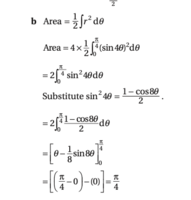
Thank you so much Dr Peterson, this is baffling for me. I got confused when they gave a question that didnt seem to add up like that, remember?
This question states:
a. sketch the graph of r= cos3[MATH]\theta[/MATH], where r>=0 and 0=<[MATH]\theta[/MATH]<2\pi.
b. Find the area of the loop of the curve with the equation r= cos 2[MATH]\theta[/MATH] for [MATH]\pi/6=<\theta=<\pi/2[/MATH]The area worked out to be the area of each petal! which is why i was confused.
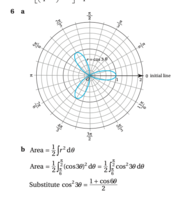
This question states:
a. sketch the graph of r= cos3[MATH]\theta[/MATH], where r>=0 and 0=<[MATH]\theta[/MATH]<2\pi.
b. Find the area of the loop of the curve with the equation r= cos 2[MATH]\theta[/MATH] for [MATH]\pi/6=<\theta=<\pi/2[/MATH]The area worked out to be the area of each petal! which is why i was confused.

Last edited:
Dr.Peterson
Elite Member
- Joined
- Nov 12, 2017
- Messages
- 16,089
Yes, that's exactly what I said.How can a definite integral be negative? | Socratic
Yes, a definite integral can be negative. Integrals measure the area between the x-axis and the curve in question over a specified interval. If ALL of the area within the interval exists above the x-axis yet below the curve then the result is positive . OR If ALL of the area within the interval...socratic.org
This is very basic maths. I am not sure why you are disagree. Ok let me check it out, you are saying its not the case for polar curves.
The integrand for a polar curve's area is a square, so it is never negative. That should be obvious. I suspect you are not looking closely at the things you are asking about (and perhaps some things your book says or does are misleading you).
Have you observed the difference between even and odd cases of [MATH]r = \cos(n\theta)[/MATH]? Your three-petal rose (n=3) is traced twice in 2 pi (total of 6 petals, so twice the actual area), while this one with eight petals (n=4) is traced once in 2 pi.
Yes thats very basic. I am still unsure why we got 1 petal area in that answer I mentioned. I am still certain to avoid pitfalls as shown in the example, you need to do petal by petal. I cant work out why I got 1 petal area for the answer.
I had not realised only get positive integrands with polar curves.
I had not realised only get positive integrands with polar curves.

